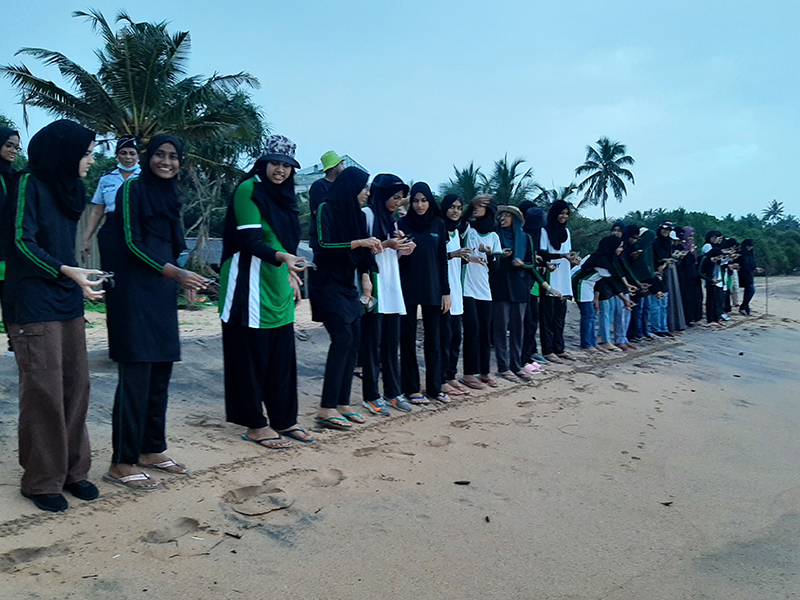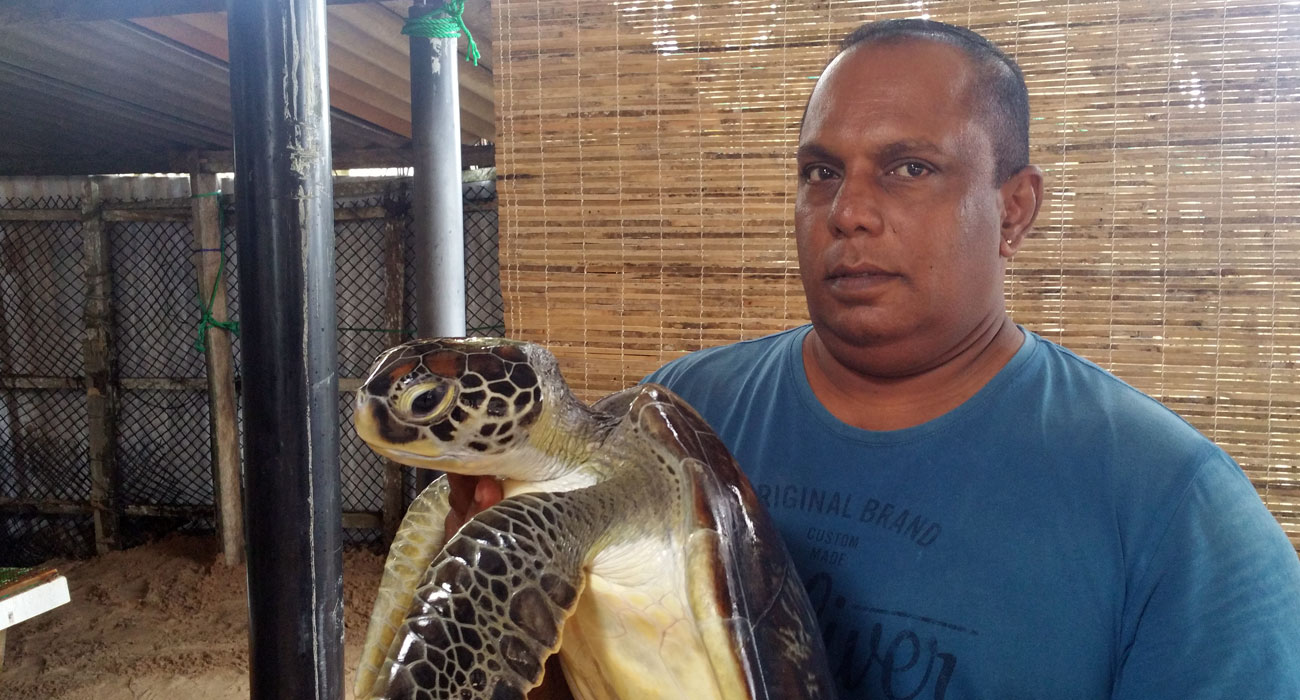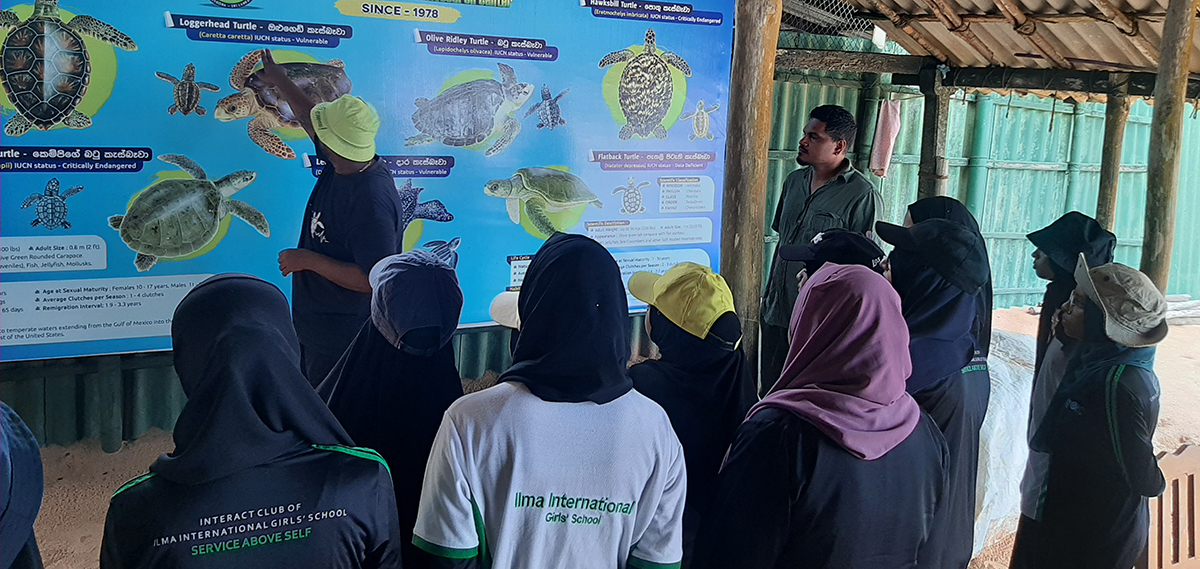Dermochelys coriacea

Distribution
These turtles are seen nesting in Sri Lanka including, Induruwa, Mawella, Ussangoda, Rekawa, Ambalangoda, Kosgoda, Bundala, Godavaya & Yala. Although leatherbacks are most often found in tropical waters, they are distributed around the globe in temperate oceans, and even on edges of sub arctic water & sub arctic oceans. They travel north & live in Northern Atlantic waters as far north as Newfoundland, Nova Scotia, and Labrador. They also inhabit South Atlantic Waters, as far south as Argentina and South Africa. This turtle inhabits waters as far east as Britain and Norway.
Characteristics
The leatherback sea turtle is the largest of living turtles. Their body is streamlined, with large muscular shoulders. They have a secondary palate, formed by vomer and palatine bones. So the shell is not very distinct. The shell is leathery, oily and cartilaginous, and strengthened by a network of numerous tiny bones. It has no claws or scales. It has 7 pronounced ridges in its back & 5 on the underside. Their eyelids are thick and close to a vertical slit. The leatherback has a unique w-shaped mouth that is well adapted for grasping.
These turtles survive in waters that are very cold, which the other sea turtles cannot tolerate. They have a network of blood vessels that work as a counter-current heat exchanger. Also a thick insulating layer of oils and fats in their skin, are able to maintain body temperatures much higher than their surroundings. They also have a heat-exchange mechanism in their shoulder area, where cool blood from the flippers is warmed before it reaches the internal organs and shoulder muscles. They have an average lifespan (captivity) of 30 years. Leatherbacks are mostly solitary.
Breeding
The female gains reproductive maturity 5-12 years (average 13 years). It’s known that the males will return to the same nesting beach if they were successful in the previous season. The male turtles will migrate just offshore a common nesting beach generally before nesting season begins. They try to mate with as many females as possible. They mate in the water. These female turtles have a gestation period of 55-75 days & then they swim ashore at night to nest and will produce a clutch which most may not contain yolk.
They lay their eggs in the sand of tropical beaches. These turtles will lay about 5-7 nests per year, re-nesting every 9-10 days. Also, they will return to the same nesting location every 2-3 years. In Sri Lanka the nesting is taking place in May & June also in October & December. The nests are deeper than all other turtles & comprise 90-130 clutches of eggs. These eggs are spherical, soft shelled & 50-54mm. There usually white but may contain green spots. After the female lays her eggs, then it cover the nest with sand to discourage predation and moderate the temperature and humidity around the eggs. After the female has completed this process she will returns to the ocean & No subsequent parental care occurs.
Nest temperature determines the hatchlings’ sex. At 29.5 degrees Celsius hatchlings are equally likely to be male or female, hatchlings incubated at 28.75°C or less will be male, & above 29.75°C they’ll be female.
Human impact & dangers
Nesting females pack the sand over their clutch of eggs, perhaps to obscure the scent of the eggs and make them harder for small predators to dig up. Hatching success of clutches is about 50% in an undisturbed nest. Many nests are destroyed by many different predators.
Hatchlings wait until nightfall to emerge and head for the water, to avoid predators. Throughout their lives leatherbacks are counter-shaded, dark on the dorsal surface and light underneath, to better blend with background light.
These turtle adults are strong and fast swimmers & they may defend themselves aggressively. The thick layer of connective tissue over bony plates covering much most of their body helps them to escape the predators to some extend. They avoid rocks which can damage the shell.
Humans are the primary predator of this species, gathering eggs and killing adults. Its flesh is sometimes toxic to humans and other animals, perhaps due to toxins ingested as part of its diet of jellyfish. Oil from the bodies of adults is extracted for medicinal use and as a waterproofing agent. The primary threat to the species is commercial fishing: turtles accidentally trapped and drowned in nets and trawls, or hooked or tangled by long lines and trap lines.
The pollution causes them death, especially when they utilize plastic bags that are indigestible.
Refference : Wild REACH








